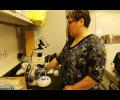
By Diana Haecker
Researchers stepping off the research vessel Norseman II in Nome last weekend, brought significant news of having found very high concentrations of a phytoplankton called Alexandrium catenella in regional waters. Alexandrium is an algae that can produce saxitoxins, which can cause dangerous paralytic shellfish poisoning in people. The scientists issued an advisory, notifying Norton Sound Health Corporation, UAF Sea Grant and the Alaska Division of Public Health.
On July 25, the researchers found an alarming count of 18,000 alexandrium cells per liter in the waters 21 miles west of Gambell. On August 11, they found an even higher concentration of the algae, 30,000 cells per liter, 60 miles north of Shishmaref.
The advisory read, “Based on studies in the Gulf of Alaska and other parts of the U.S. and the world, concentrations of the algal Alexandrium catenella at this level are considered dangerous and are high enough to trigger an advisory for nearby communities to be cautious when consuming marine wildlife resources, such as clams, crabs and tunicates.
Marine wildlife that have consumed the algae might currently may have a high concentration of saxitoxin that could affect human and animal health. Marine wildlife will ingest the concentrated biotoxins when they eat the clams containing the biotoxins. They can also accumulate toxins by feeding on zooplankton, filter-feeding fish, tunicates, and other animals within the food web. It is not yet known what the risk is to seabirds and marine mammals, or to humans who consume those resources.”
Don Anderson is a senior scientist at Woods Hole Oceanographic Institution in Massachusetts, which lead the National Science Foundation-funded research cruise specifically to investigate harmful algal blooms in the Chukchi and Beaufort Sea. He said in an interview with The Nome Nugget that the advisories are not meant to be alarmist but aim to inform people and to tell local communities to be cautious. “There are certain things that you just shouldn’t do in the areas where these blooms are being reported,” he said. “One of them is to eat shellfish, clams, mussels, even clams that have been taken out of a walrus stomach could be very dangerous.”
The organism called alexandrium occurs in more temperate ocean environments such as Southeast Alaska in quite large numbers and causes toxicity in algae-eating shellfish. Most algae are harmless, but algal blooms of alexandrium can produce very a very dangerous biotoxin called saxitoxin. In areas where clams or mussels are harvested, people do run the risk to suffer from a condition called paralytic shellfish poisoning, PSP for short, when eating shellfish containing saxitoxin. The problem with saxitoxin is that people cannot see, smell, or taste it.
Also, cooking or freezing these foods will not lessen the toxin’s effect.
PSP affects the nervous system and blocks nerve function. If high concentrations of saxitoxin are eaten, breathing difficulties and paralysis occurs in humans, marine mammals and seabirds. Consuming walrus intestine, stomach and their contents in areas with known biotoxins likely has the same risk as consuming shellfish from those areas.
Since subsistence harvest of mussels and clams is considered recreational, the state does not test for saxitoxin in shellfish as it does for commercially harvested shellfish.
In response to the news, Norton Sound Health Corporation stepped up its water sampling program, said NSHC Public Relations Manager Reba Lean. “NSHC’s Office of Environmental Health department runs the program and had hoped to start establishing a baseline on phytoplankton numbers around the region this year,” she said. With sampling for harmful algal blooms in mind, NSHC has offered trainings to tribal environmental programs in the region, said Lean.
Not wasting any time after receiving the advisories from the Norseman II scientists, Environmental Health Coordinator Emma Pate went out and sampled water off Cape Nome on Tuesday morning. Looking at the sample through a microscope, she points to an organism on the screen, identifying it as pseudo-nitzschia cells, which can cause domoic acid, another harmful biotoxin. Pate will be testing water samples on a weekly basis, looking for three target algal species that produce different biotoxins: alexandrium cantenella, dinophysis and pseudo-nitzschia. She had been working to stand up trial basis testing for water samples regionwide and Norton Sound has signed a Cooperative Research and Development Agreement with NOAA to receive technical assistance. The purpose was to get a baseline of water samples but with the news from the Norseman, the testing has now locally been ramped up.
Gay Sheffield with UAF Sea Grant said that while low level algal blooms are not new to the region, the high numbers of cells detected are. “With warming water, the concern is for an uncontrollable growth event, or bloom,” she said. “For this event, we will respond to all reports of sick or dead marine wildlife. People should remain vigilant and report the unusual when they see it.”
Researching harmful algal blooms
While the amount of alexandrium cells in the water was super high, the degree of toxicity is not yet known as the researchers need to further analyze the water samples.
Normally, the region would have had to wait until the analysis were done to learn of algal blooms, months after the fact. What is new this time around, is that researchers could get off the boat and immediately share the information with the region. The toxicity analysis, however, will take another month or so to be done, said Anderson. A new instrument on board the research vessel allowed researchers in real time to realize that the amount of alexandrium in these two places was off the charts and thus they were able to promptly issue advisories.
Anderson said it usually takes weeks or even months to analyze the water samples, but the new piece of equipment provided real-time results. “The acronym for it is IFCB, which stands for Imaging Flow Cyto Bot,” he said. It is a submersible microscope taking about 10 high resolution images every second of particles in the water. “As the ship was cruising, water from the surface of the ocean was being fed to this instrument, which was then taking pictures of all the algae and other animals in the water, and we were able to then get an accurate count of the cells of alexandrium that are there. It’s using a technology very similar to facial recognition but in this case, artificial intelligence is using being used to identify the toxic alexandrium cells, out of the many, many other cells that are also living out there with it.”
Anderson said in prior cruises to the region, they did find 5,000 or 8,000 cells per liter. To put the numbers in context, Anderson explained that in the Gulf of Maine, 1,000 or 2,000 alexandrium cells per liter “are more than enough to make shellfish consumption dangerous and it’s enough to close an entire coastline for shellfish harvesting.”
Harmful algal blooms are not new to this region and a study has shown that traces of biotoxins from harmful algal bloom have been found in many marine species – including invertebrates, zooplankton, forage fish, seabirds and marine mammals— in Alaskan Arctic waters. In 2017, 39 walrus carcasses were found, stranded on beaches on the northern Seward Peninsula and barrier islands. While most carcasses were too far gone to be sampled, four samples turned out to have moderate to high saxitoxin. One freshly harvested walrus in 2016 had very high saxitoxin levels. But scientists still don’t know the levels of saxitoxin that would sicken or kill walruses, seals or sea birds, and if and where the toxins accumulate in the body. Seabirds also died in great numbers, but saxitoxin was ruled out as the cause of death.
The Norseman II cruise’s purpose was mainly to investigate the mechanism of how harmful algal bloom pop up where they do. Anderson explained that algal blooms have been transported from the south via currents through the Bering Strait for decades. But researchers also more recently found so-called cyst beds of dormant alexandrium at Ledyard Bay and offshore from Utqiagvik. “During the winter, it’s just down there in the mud, dormant, and then in the summer, it will wake up basically, and germinate,” Anderson said. “But we’ve always felt that the water was too cold up there, for there to be any sort of significant germination. In some of the cruises we’ve had over the last several years, though, we found that the water is actually much warmer than we thought.” This discovery led to the theory of a second mechanism for these blooms, namely that they can actually germinate there and just go from the bottom up into the surface waters to the sunlight. “The thing that is new, we think, is that the waters are warm, and the blooms originate in the Chukchi Sea. That’s new,” said Anderson.
Another component of the cruise was also how saxitoxin moves through the food web. While the risk of eating shellfish is known, the risks of consuming subsistence species such as walrus or seals, sea birds or even forage fish, are not. “It’s such a new problem and because we’ve only started the studies in the last few years, we don’t have the knowledge yet to give real definitive guidance to people. So, we can say ‘Please be careful, don’t eat birds and animals that are acting strange.’ But we also don’t want people to stop fishing and hunting.”
Since there is much to be learned, Anderson seeks help from the communities by collecting water samples and to collect samples of animals or “other things that might be vectors that we can analyze, so we can get data to go along with what we saw on the cruise.”
According to a scientific paper by Anderson, the algal blooms document a significant threat to food security to the region, while at the same time adding another stressor to ecosystem undergoing unprecedented changes due to a warming climate. “Alexandrium catenella blooms thus represent a significant threat to Alaskan Arctic ecosystems and to the human communities that depend on these resources for food and survival.”
The Norseman II crew will continue to report what they see as this cruise continues its work in the Northern Bering Sea, Chukchi Sea, and Beaufort Sea, the advisory said.
If you feel sick from eating clams, crab guts/butter, or other shellfish, please contact your health care provider immediately.
If you see any marine wildlife acting in an unusual manner or dead please contact:
Alaska Sea Grant (Nome) – Gay Sheffield: (907) 434-1149
Kawerak (Nome) – Brandon Ahmasuk: (907) 443-4265
NOAA Alaska Marine Mammal Stranding Network: (877) 925-7773
NSB-Dept. of Wildlife Management (Utqiaġvik): (907) 852-0350
USFWS – Marine Mammals Management: (800) 362-5148
For information on harmful algae toxins call Alaska Section of Epidemiology at (907) 269-8000 Mon-Fri or (800) 478-0084 after hours.








